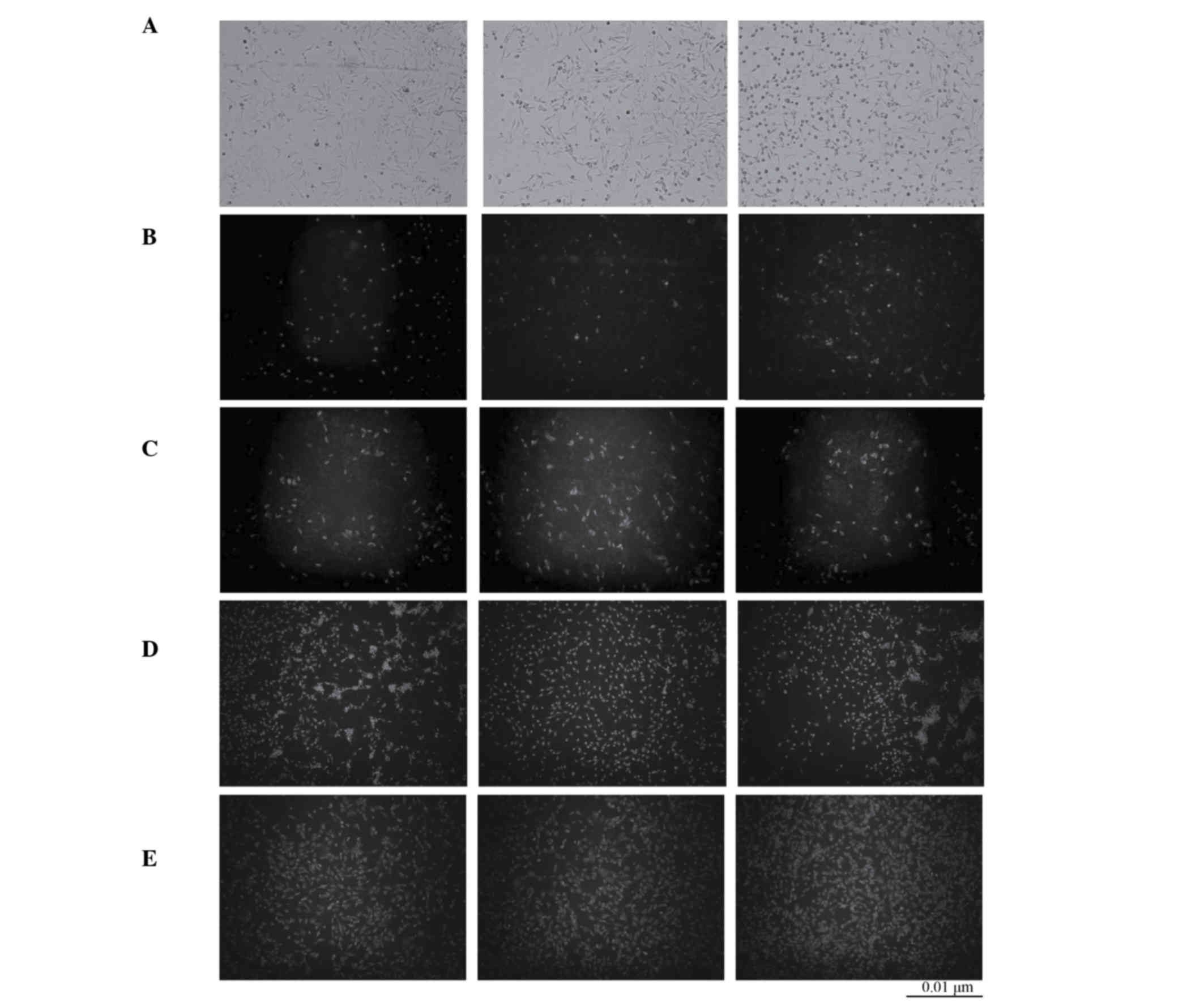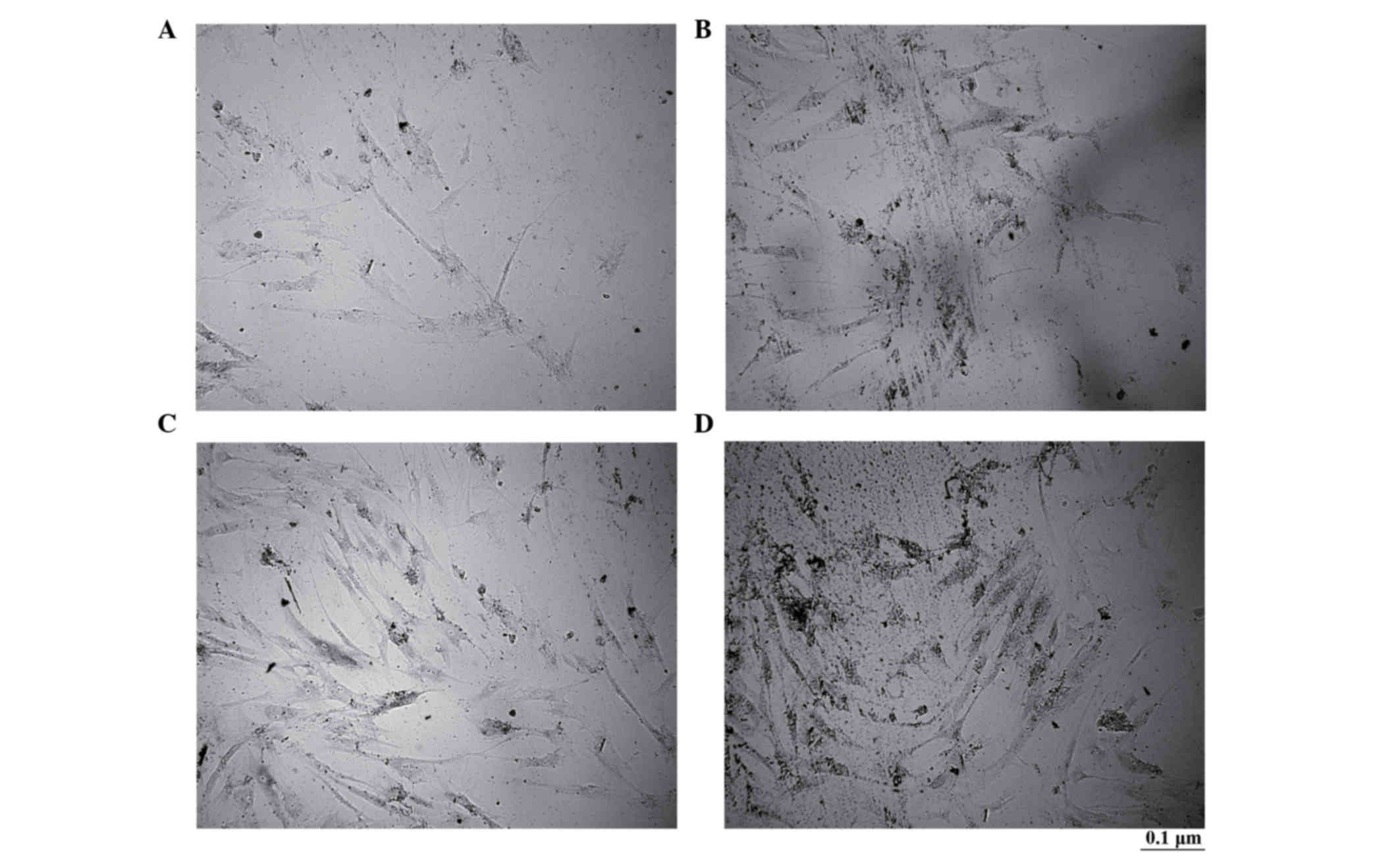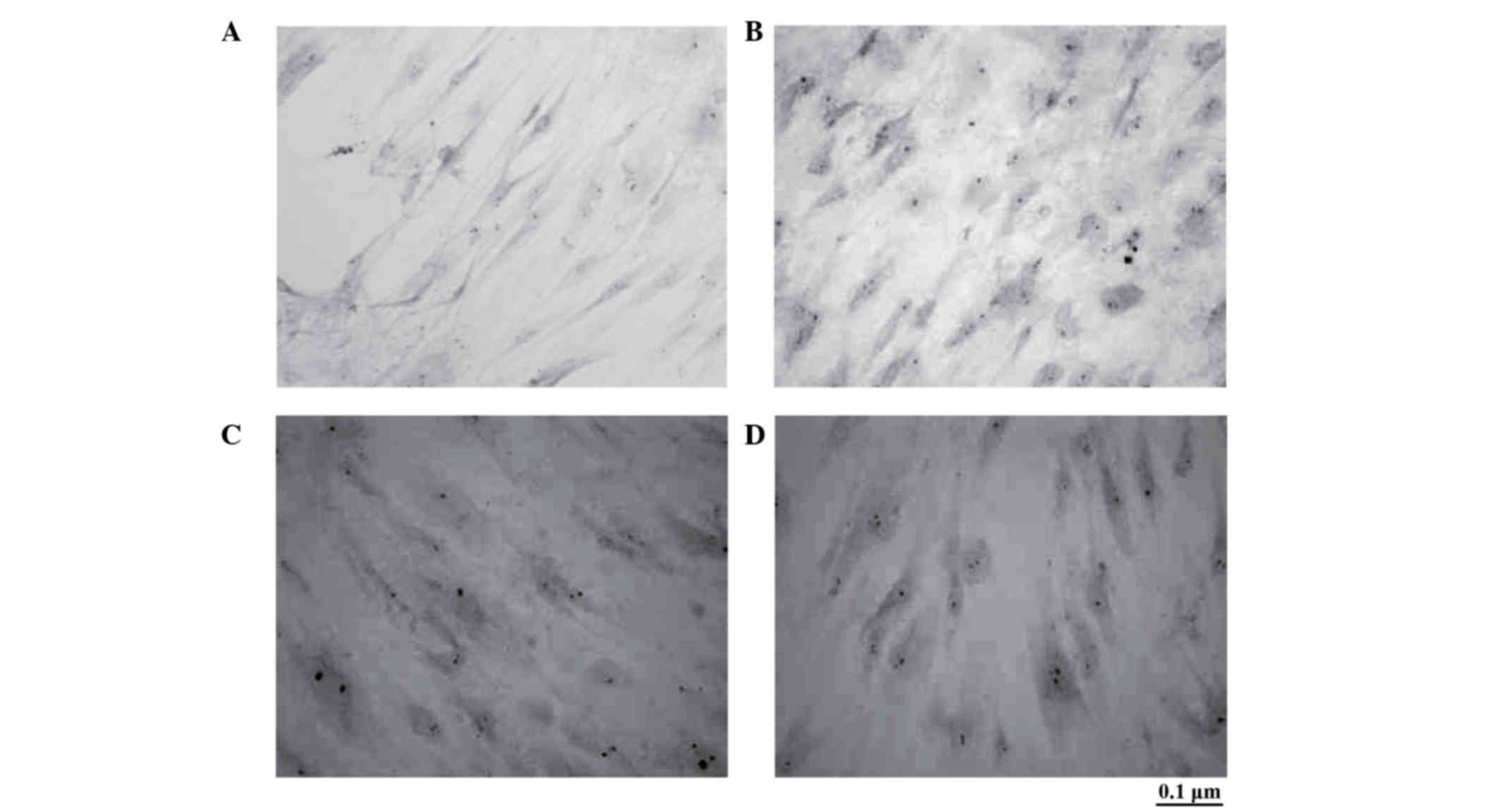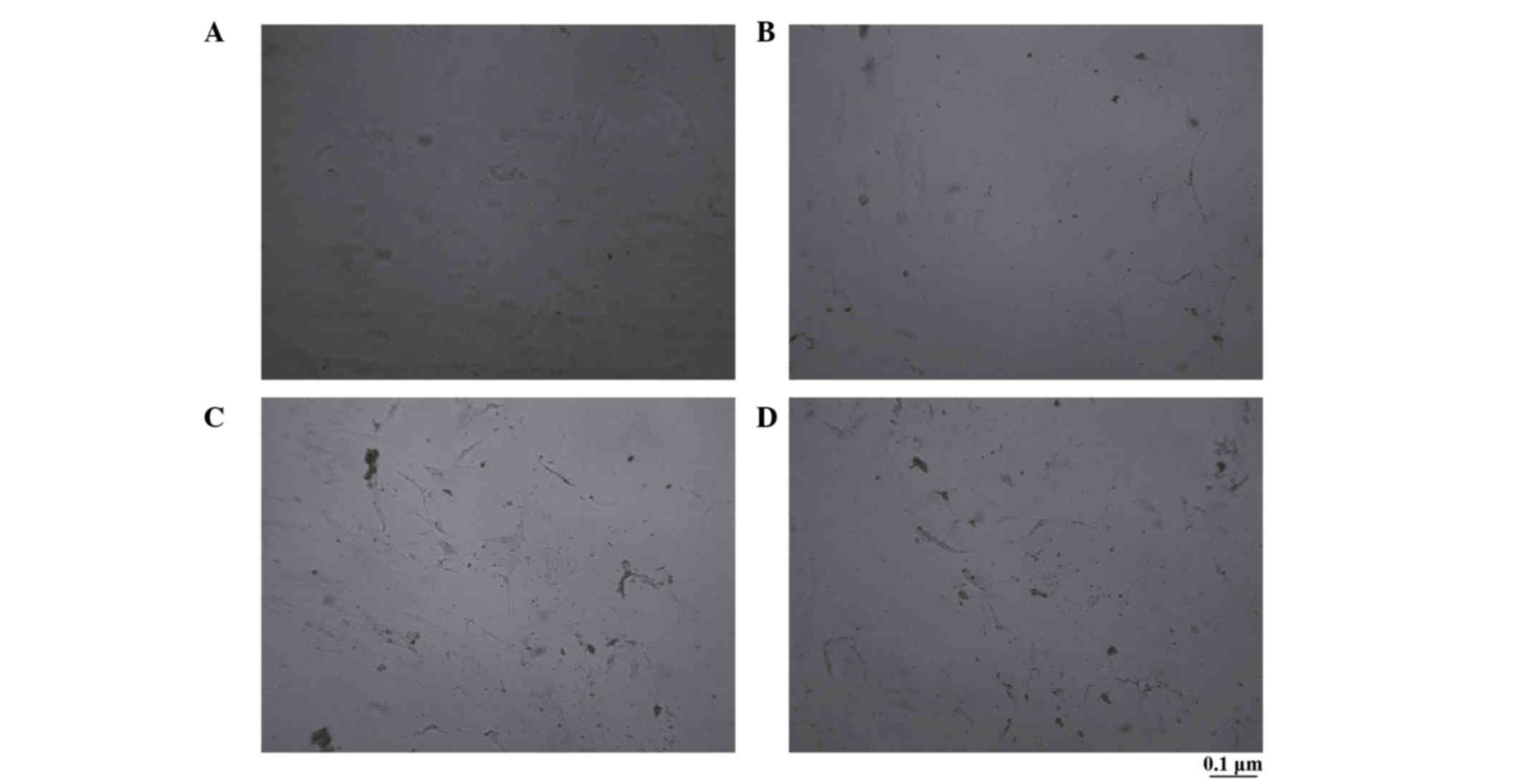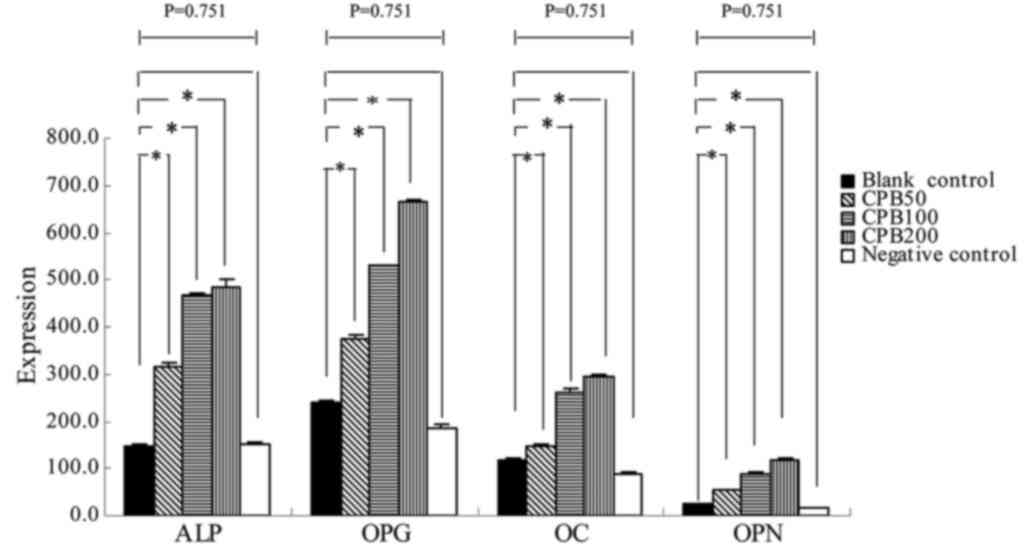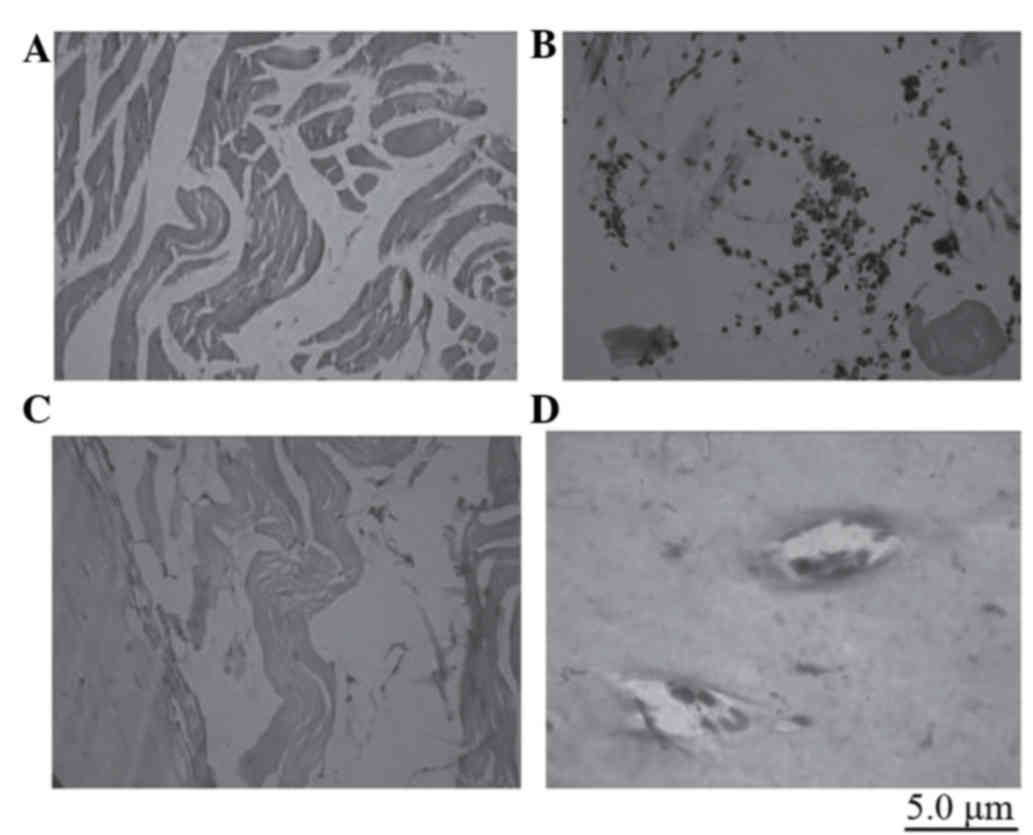Differentiation of osteoblast‑like cells and ectopic bone formation induced by bone marrow stem cells transfected with chitosan nanoparticles containing plasmid‑BMP2 sequences
- Authors:
- Published online on: January 17, 2017 https://doi.org/10.3892/mmr.2017.6128
- Pages: 1353-1361
Abstract
Introduction
Bone tissue engineering provides a method for repair of bone defects (1,2). The rapid development of bone tissue engineering in combination with neogenetic osteoblast-like cells, bone tissues induced by seed cells, genetic carrier delivery systems, bioscaffolds and growth factors may have the potential to replace autogenous bone transplantation in segmental bone repair (3,4). Previous studies have used techniques on the nanometer scale for tissue engineering (5,6).
Bone marrow stem cells (BMSCs) may be induced to differentiate into osteoblast-like cells during osteogenesis. However, there is a limited number of BMSCs in the bone marrow, and BMSCs alone are unable to induce new bone formation (7). Therefore, it is difficult to use only BMSCs to promote the repair of bone defects. In order to induce BMSCs to differentiate into osteoblast-like cells, bone growth factors are required (8).
Bone morphogenetic protein 2 (BMP2) is a bone growth factor that may be used to induce osteogenesis (9). However, it is difficult to sustain the slow release of high concentrations of exogenous bone growth factors in the region of the bone defect. In addition, high doses of exogenous bone growth factors may lead to adverse side-effects in the patient. Therefore, it is crucial to identify a method of releasing BMP2 slowly, and at high concentrations, within the regions of defective bone by using genetic carriers (10).
Non-viral carriers are safer alternatives to viral carriers (11). Chitosan is a biocompatible and bioresorbable polymer of N-acetylglucosamine and glucosamine, and it is extensively used as a carrier for bone growth factors (12). Favorable characteristics of chitosan for this purpose include its easy availability, low cytotoxicity, low immunogenicity, excellent biocompatibility and improved biodegradability. A previous study confirmed that chitosan may deliver exogenous BMP2 into various seed cells, such as BMSCs (13). In addition, chitosan nanoparticles are advantageous for delivering bone growth factors or gene sequences into seed cells in order to induce the formation of bone tissues with high efficiency (14) due to their excellent properties of infiltration and absorption. In the course of delivery, DNA combined with chitosan nanoparticles was effectively protected, and consequently, genes and proteins remained functional for longer periods of time.
In our previous study, chitosan nanoparticles containing plasmid-BMP2 (pBMP2) sequences (CNPBs) were constructed through using re-coacervation and gene recombination techniques (15). Our previous study determined that the average diameter of chitosan nanoparticles was 90±20 nm. CNPBs with higher enveloping ratios were able to effectively protect BMP2 genes. Following incubation of BMSCs with CNPBs for 12 days, cells had maintained their normal morphology and function (15).
In the present study, CNPBs were constructed with different concentrations of pBMP2, specifically containing 50 µg/ml (CPB50), 100 µg/ml (CPB100) or 200 µg/ml (CPB200) pBMP2. Following treatment with CNPB, groups were separately phagocytized by BMSCs. The transfection efficiency of the CNPBs was confirmed, and features of osteoblast-like cells derived from BMSCs were observed through histological staining, including alkaline phosphatase, Wright's and von Kasso staining. Expression levels of osteoblast-associated molecules, such as alkaline phosphatase (ALP), osteoprotegerin (OPG), osteocalcin (OC) and osteopontin (OPN), were detected and analyzed in the differentiated osteoblast-like cells. Ectopic bone formation was observed following the integration of polyglycolic acid (PGA) scaffolds with CNPBs and BMSCs, which were implanted into the dorsal muscles of Sprague-Dawley rats.
Materials and methods
Ethics statement
All animals used in this study were provided by the experimental animal center of Zhejiang University, (Zhejiang, China). The animal use and care protocol was approved by the Institutional Animal Use and Care Committee of Zhejiang University. Experimenters were approved through the Health Department of Zhejiang Province for experiments with animals (certificate no. ×0901616).
Culture of BMSCs and construction of CNPBs
A total of 10 female Sprague Dawley rats were anesthetized with pentobarbital sodium (50 mg/kg, Sigma-Aldrich Merck Millipore, Darmstadt, Germany) and sacrificed by cervical dislocation (6-weeks old; weight, 180–220 g; sanitary degree). The animals were kept in air-circulated housing a 14 h light/10 h dark cycle at 22±2°C. Bones were dissected from the rats using a surgical knife. Bone marrow cavities of tibias and femoral bones were rinsed using phosphate buffered saline (PBS). Cells were centrifuged at 300 × g for 5 min at 37°C and cultured in Dulbecco's modified Eagle's medium (DMEM; GE Healthcare Life Sciences, Logan, UT, USA) containing 10% fetal bovine serum (FBS; Gibco; Thermo Fisher Scientific, Inc., Waltham, MA, USA). Next, BMSCs were subjected to digestion with 0.25% trypsin (Gibco; Thermo Fisher Scientific, Inc.), cells were cultured until passage 3 and used in the subsequent experiments. In our previous study (15), CNPBs were constructed using re-coacervation and gene recombination techniques. Escherichia coli bacteria were transfected with plasmids (cat. no. 6085-1; Addgene, Cambridge, MA, USA) that included an insertion of BMP2 cDNA, and extracted plasmid-DNA was subjected to restriction enzyme analysis. The successful insertion of BMP2 cDNA fragments was confirmed through DNA sequencing, performed by the laboratory in Zhejiang University (Hangzhou, China). Purified pBMP2 was dissolved into Na2SO4 solution. The concentrations of pBMP2 used were 50, 100 or 200 µg/ml. Subsequently, chitosan was mixed with the different concentrations of pBMP2 to form CNPBs (CPB50, CPB100 and CPB200, respectively). Chitosan was purchased from Sigma-Aldrich; Merck Millipore (50 g; cat. no. 448877) (15).
Transfection efficiency of CNPBs
Experimental groups were established as follows: i) Blank control (untreated BMSCs); ii) positive control (200 µg/ml pBMP2); iii) CPB50 (chitosan + 50 µg/ml pBMP2); iv) CPB100 (chitosan + 100 µg/ml pBMP2); and v) CPB200 (chitosan + 200 µg/ml pBMP2). BMSCs were seeded into 6-well culture plates (5.0×105 cells/well) for 24 h. Following the removal of DMEM, BMSCs were rinsed using 1 ml DMEM. Next, pBMP2 and the different CNPB concentrations were added separately into the experimental wells for a 6-h incubation with Lipofectamine 2000 (Invitrogen; Thermo Fisher Scientific, Inc.). Green fluorescent protein (Guduo Corporation, Shanghai, China) was used as reporter. Following the removal of the transfection solution, BMSCs were continuously cultured with DMEM containing 1 ml 10% FBS for 24 h. BMSCs transfected with CNPBs were photographed using an inverted fluorescence microscope (XD30-RFL; Sunny Instruments Co., Ltd., Ningbo, China). The number of, and total area occupied by, the cells in the micrographs were analyzed using ImageJ version 1.42 (National Institutes of Health, Bethesda, MD, USA).
Cellular staining
Alkaline phosphatase staining, Wright's staining, and von Kossa staining were used for identification of osteoblast-like cells differentiated from the transfected BMSCs. Experimental groups included: i) Blank control; ii) CPB50; iii) CPB100; and iv) CPB200. Initially, BMSCs were seeded into 6-well culture plates (1.0×105 cells/well) and maintained overnight. Next, DMEM was removed, cells were rinsed using 1 ml DMEM, the various concentrations of CNPB were added for the aforementioned specific treatment groups, and the cells were cultured for 24 h at 37°C.
For alkaline phosphatase staining, the transfected BMSCs were fixed for 10 min in 4% paraformaldehyde and then rinsed using distilled water for 5–10 min. Cells were immersed in alkaline phosphatase solution for 25 min at 37°C. Finally, cells were rinsed using distilled water for 5–10 min.
For Wright's staining, the transfected BMSCs were rinsed with PBS and fixed in methanol for 3–5 min. Cells were treated with Wright's staining solution for 2 min. Subsequently, transfected BMSCs were treated with Wright's phosphate buffer solution for 4–10 min and rinsed using distilled water.
Von Kossa staining was performed after transfected BMSCs were fixed in 4% paraformaldehyde for 15 min. The cells were then rinsed with distilled water. Then, cells were treated in 1% silver nitrate solution and incubated under an ultraviolet lamp for 15 min. Finally, the cells were stained with 5% natrium hyposulfurosum solution (Shengrui Transmission Corporation Ltd., Xian, China) for 2 min.
Reverse transcription-polymerase chain reaction (RT-PCR)
Experimental groups included: i) Blank control; ii) CPB50; iii) CPB100; and iv) CPB200. BMSCs were seeded into 6-well culture plates (1.0×105 cells/well) for 24 h culture, pBMP2 was added, and each of the CNPB treatment groups were set up in separate experimental wells for a 48 h transfection. RT-PCR was used to determine the mRNA expression levels of ALP, OPG and OC in osteoblast-like cells. mRNA was extracted using TRIzol reagent (Invitrogen; Thermo Fisher Scientific, Inc.). The primers used for RT-PCR of ALP, OPG and OC are presented in Table I. A PCR kit with DNA-free sensitive Taq DNA polymerase (Amresco, LLC, Solon, OH, USA) was used. The RT conditions were: 37°C for 1 h and 95°C for 5 min in order to deactivate M-MLV reverse transcriptase. The thermocycling conditions were as follows: 95°C for 15 min, 30 cycles at 95°C for 15 sec, 52°C 30 sec, 72°C for 30 sec and 72°C for 2 min.
Western blotting
Protein expression levels of OPN in cells was detected using western blot analysis. Cells were rinsed twice using PBS. Cell lysis buffer (100 µl) was added into each culture well (cat. no. P0013; Beyotime Institute of Biotechnology, Beijing, China). Cells were centrifuged for 5 min at 300 × g at 37°C. Polyvinylidene fluoride membranes (Merck Millipore) were rinsed using PBS with Tween-20 (PBST). The membranes were incubated with the rabbit anti-OPN primary antibody (cat. no. 000019-R; 1:500; CellChip Biotechnology Co., Ltd., Beijing, China) for 1 h at 37°C. PBST was used to wash the membranes 4 times for 10 min each. The membranes were then incubated for 1 h with a secondary biotin-labeled rabbit anti-goat IgG antibody (cat. no. E030330; 1:5,000; EarthOx Life Sciences, Millbrae, CA, USA). PBST was used to wash the membranes 4 times for 10 min each. The protein was then visualized using a Developer and fixer kit (cat. no. P0019, Beyotime Institute of Biotechnology), and the development time was 1–2 min.
Ectopic bone formation
Polyglycolic acid scaffold materials (Dexon, Shanghai, China) were sterilized using 75% alcohol and then cut into 0.5×0.5×0.5 cm2 pieces. The PGA scaffolds were soaked in DMEM for 2 h, then 2 ml BMSCs (5.0×107 cells/ml) were seeded into the scaffolds as the negative control group. The following treatment groups were seeded onto the scaffolds: i) BMSCs + PGA + CPB50; ii) BMSCs + PGA + CPB100; and iii) BMSCs + PGA + CPB200. The PGA scaffolds were incubated for 5 days to ensure that cells and carriers had adhered successfully. The scaffolds were then implanted into the dorsal muscles of rats in order to determine the ectopic bone formation. Three scaffolds were implanted per treatment group. After 2 months, the 4 rats were euthanized by cervical dislocation and the regions with the implanted scaffolds were dissected. The tissues were then subjected to hematoxylin and eosin staining.
Statistical analysis
Data are presented as the mean ± standard error. One-way analysis of variance was performed using SPSS version 17.0 software (SPSS, Inc., Chicago, IL, USA). P<0.05 was considered to indicate statistically significant difference.
Results
Transfection efficiency of CNPBs
Following 24 h transfection of BMSCs no green fluorescence was observed in the blank control BMSC (untreated) group. However, green fluorescence was observed in the pBMP2 (positive control) and CNPB at different concentrations groups. This indicated that chitosan nanoparticles delivered the BMP2 gene into BMSCs and successfully displayed green fluorescence. The fluorescence of the pBMP2 and CPB50 groups was weaker compared with the CPB100 and CPB200 groups and particle analysis revealed that there was a greater quantity of fluorescence particles and in greater total areas in the CPB100 and CPB200 groups (Table II, and Figs. 1 and 2). Statistical analysis revealed that there was a significant difference in particle quantity among the groups (P<0.0001). Pairwise comparisons determined that there was a significant difference in particle quantity between any two groups, with the exception of the CPB50 and pBMP2 groups (P=0.243). There was also a significant difference in total areas with fluorescence particles among the groups (P<0.0001). The difference in total areas between any two groups was significant, except between the CPB100 and CPB200 treatment groups (P=0.321; Table II, Figs. 1 and 2).
Table II.Quantity and total area of fluorescence particles in every group following transfection of bone marrow stem cells with chitosan nanoparticles containing plasmid-bone morphogenetic protein 2 sequences. |
Alkaline phosphatase staining of osteoblast-like cells differentiated from transfected BMSCs with CNPBs
There were no obvious brownish-black particles observed in the control group; however, there were numerous brownish-black particles in the CPB50, CPB100 and CPB200 groups. In addition, more particles were observed in the CPB200 group compared with the CPB50 and CPB100 groups (Fig. 3).
Wright's staining of osteoblast-like cells differentiated from BMSCs transfected with CNPBs
The staining revealed that BMSCs of a smaller size were fibriform in the control group (Fig. 4A). However, osteoblast-like cells that differentiated from BMSCs were observed to be larger in size, with inflated cell bodies and nucleoli stained dark blue in the CBP50, CBP100 and CBP200 treatment groups. In addition, osteoblast-like cells also had characteristic stick-like prominences (Fig. 4).
Von Kossa staining of osteoblast-like cells differentiated from BMSCs transfected with CNPBs
No staining was observed in the control group (Fig. 5A). Black particles, indicating a positive reaction of calcium phosphate in the mineralized extracellular matrix of osteoblasts, were observed in the CPB50, CPB100 and CPB200 treatment groups (Fig. 5B-D).
Expression levels of ALP, OPG, OC and OPN in osteoblast-like cells differentiated from BMSCs transfected with CNPBs
The RT-PCR determined that the mRNA expression levels of ALP, OPG, OC and OPN were increased in the CNPB treatment groups compared with the blank and negative control groups (Fig. 6). The highest mRNA expression levels of ALP, OPG, OC and OPN were identified in the CPB200 treatment group (Table III; Figs. 6–8). Statistical analysis revealed that there was a significant difference between any two groups (P<0.0001), except between the blank and negative control groups (P=0.751).
Table III.Expression levels of ALP, OPG, OC, and OPN in osteoblast-like cells differentiated from BMSCs transfected with CNPBs. |
Ectopic bone formation
Two months after the PGA scaffolds that were integrated with BMSCs transfected with CNPBs were implanted into the muscles of rats, by touch, the sensation of a ‘string-like’ object in the subdermal implanted regions of the control and CPB50 groups was identified. However, a node-like object was identified in the subdermal implanted regions of the CPB100 and CPB200 groups. After the implanted regions were excised, numerous muscle fibers were observed in the control and CPB50 groups. In the CPB100 and CPB200 groups, a dark-red node with white spots was identified, which was surrounded by fibrous tissues. Histological staining revealed that there was novel bone formation had occurred in the CPB100 and CPB200 treatment groups (Fig. 9). This bone formation was more evident in the CBP200 group. In the positions of white spots were determined to be cartilage islands (Fig. 9). The PGA scaffolds were absorbed in all treatment groups.
Discussion
Chitosan is considered to be an effective non-viral carrier and is extensively used for tissue engineering (13,16). In our previous study (15), chitosan nanoparticles had excellent biocompatibility. On the basis of these results, the present study used chitosan nanoparticles as carriers of genetic material. CNPBs had excellent transfection efficiency to BMSCs and induced the differentiation and proliferation of osteoblast-like cells. In addition, CNPBs induced ectopic formation of new bone in rats. Therefore, the present study determined that CNPBs are promising carriers of genetic material.
BMSCs have been used extensively in bone tissue engineering. As BMSCs are capable of multi-directional differentiation, bone growth factors and osteogenesis are important factors to consider for successful bone tissue engineering. Bone growth factors primarily include the BMP family, transforming growth factor-β, dexamethasone, the active form of vitamin D [1,25-(OH) 2D3], vitamin C and sodium glycerophosphate. The exogenous BMP family is a group of acid polypeptides with low molecular weights. BMP2 may promote cell proliferation and induce seed cells to differentiate into osteoblast-like cells, which may result in the formation of new bone. Hou et al (16) determined that BMP2 had potent osteoinductive properties in bone regeneration (16). The composite scaffold that Hou et al (16) constructed of recombinant human BMP2 (rhBMP2)-loaded collagen/chitosan microspheres bridged bone defects and recanalized the bone-marrow cavity. The results of a previous study indicated that BMP2 alone had a positive effect on bone regeneration (17). Yilgor et al (18) revealed that treatment with BMP2 alone resulted in a higher ALP activity compared with treatment with BMP7 (18).
In the present study, BMSCs were transfected with CNPBs. BMP2 was released continuously during osteogenesis to promote formation of new bone. Therefore, the present study determined that BMSCs transfected with CNPBs at a higher efficiency. The phenotype of osteoblast-like cells was confirmed using alkaline phosphatase, Wright's, von Kossa staining. In addition, the mRNA and protein expression levels of ALP, OPG, OC and OPN in osteoblast-like cells differentiated from the transfected BMSCs were recorded at higher levels compared with the control group, which had untreated cells. In order to determine the extent of ectopic bone formation, CNPBs were attached to PGA scaffolds to induce new bone formation following implantation into the dorsal muscles of rats.
Chitosan gels loaded with BMP2 enhanced ALP activity in BMSCs by 3.6-fold, and increased the calcium mineral deposition of mesenchymal cells by 2.8-fold (19). In addition, chitosan gels loaded with BMP2 induced synthesis of OC in BMSCs (19). The present study was consistent with the findings of previous studies (20–22). Zhao et al (20) determined that a calcium phosphate-chitosan fibrous scaffold delivery system with BMP2 promoted osteo-differentiation and resulted in increased gene expression levels of ALP and OC (20). Shi et al (21) demonstrated that carboxymethyl chitosan-BMP2 modified substrates significantly promoted ALP activity and calcium mineral deposition of osteoblasts and human bone marrow-derived mesenchymal stem cells (21). Additionally, bone formation was observed in the quadriceps muscles of rats following the implantation of rhBMP2-loaded chitosan carriers (22).
The BMP2-induced differentiation of BMSCs into osteoblast-like cells ensures that BMP2 is able to recruit BMSCs and promote their proliferation. During bone formation, BMP2 promotes cellular differentiation and proliferation through autocrine and paracrine secretion. Following BMP2 binding to the BMP2-specific receptor on the cell surface, Smad protein becomes activated through signal transmission. Subsequently, Smad protein is transported into the cell nuclei. Next, the nuclear factor, runt-related transcription factor 2 (Runx2; also known as core-binding factor subunit-α1), is activated through the mitogen-activated protein kinase pathway. Following the combination of Runx2 with Smad, specific phenotypes in osteoblast-like cells are activated sequentially (16–22). Finally, expression levels of ALP, OPG, OC and OPN were upregulated, and BMSCs were differentiated into osteoblast-like cells.
Scaffold materials may primarily include natural and synthesis polymer and bioceramics (23). Natural polymers such as collagen, chitosan-alginate gel and hyaluronic acid may be used. Synthesized polymers that are biodegradable include polyactide, polyviol, polyacrylic acid and polyethylene glycol. The primary bioceramics used are calcium phosphate ceramics, hydroxyapatite and calcium carbonate (24,25). Chen et al (26) used bilayered integrated scaffolds in their study. Their findings revealed that mesenchymal stem cells seeded in each layer of the bilayered gene-activated osteochondral scaffold had a higher expression of BMP2 protein (26). Park et al (27) determined that chitosan-alginate gel/mesenchymal stem cell/BMP2 composites were able to stimulate novel bone formation. The primary aim of tissue engineering is to construct a three-dimensional complex composed of seed cells and biomaterials. Therefore, PGA scaffolds with the same excellent biocompatibility and biodegradability have been used extensively in bone tissue engineering. The present study involved the transfection of BMSCs with CNPBs, and they were subsequently incubated with PGA scaffolds. Cells adhered to, and proliferated on, the PGA scaffolds. The histological staining revealed that the PGA scaffolds had successfully degraded, and novel bone formation was observed. The present study determined that PGA scaffolds with three-dimensional structures provided a larger surface area, and simulated the formation of natural bone structures. This allowed for the slow release of BMP2 in the CNPBs, providing an excellent ‘shelter’ for osteoblast-like cells differentiated from BMSCs. This promoted the osteogenic functions of osteoblast-like cells.
In conclusion, in the present study CNPBs were successfully transfected into BMSCs with a high efficiency, and BMSCs were promoted to differentiate into osteoblast-like cells in vitro. Additionally, CNPBs upregulated the expression levels of ALP, OPG, OC and OPN in osteoblast-like cells and induced the formation of new ectopic bone in vivo.
Acknowledgements
The present study was supported by the Department of Education Foundation of Zhejiang Province of China (grant nos. 20080180, Y201018976 and N20110143), Zhejiang Provincial Natural Science Foundation of China (grant nos. Y2080340 and LY12H14004) and Zhejiang Provincial and Ministry Joint Project (grant no. WKJ2011-2-009).
Glossary
Abbreviations
Abbreviations:
|
BMP2 |
bone morphogenetic protein 2 |
|
CNPBs |
chitosan nanoparticles containing plasmid-bone morphogenetic protein 2 sequences |
|
BMSC |
bone marrow stem cells |
|
pBMP2s |
plasmid-BMP2s |
|
PGA |
polyglycolic acid |
|
GFP |
green fluorescent protein |
References
|
Amini AR, Laurencin CT and Nukavarapu SP: Differential analysis of peripheral blood- and bone marrow-derived endothelial progenitor cells for enhanced vascularization in bone tissue engineering. J Orthop Res. 30:1507–1515. 2012. View Article : Google Scholar : PubMed/NCBI | |
|
Takekawa M, Matsuda M and Ohotubo S: Effect of irradiation on autogenous bone transplantation in rat parietal bone. Histol Histopathol. 15:7–19. 2000.PubMed/NCBI | |
|
Erlwein O and McClure M: Gene delivery the key to gene therapy: The case for foamy viruses. Ther Deliv. 2:681–684. 2011. View Article : Google Scholar : PubMed/NCBI | |
|
Moawad HM and Jain H: Fabrication of nano-macroporous glass-ceramic bioscaffold with a water soluble pore former. J Mater Sci Mater Med. 23:307–314. 2012. View Article : Google Scholar : PubMed/NCBI | |
|
Fazil M, Md S, Haque S, Kumar M, Baboota S, Sahni JK and Ali J: Development and evaluation of rivastigmine loaded chitosan nanoparticles for brain targeting. Eur J Pharm Sci. 47:6–15. 2012. View Article : Google Scholar : PubMed/NCBI | |
|
Yadav A, Lomash V, Samim M and Flora SJ: Curcumin encapsulated in chitosan nanoparticles: A novel strategy for the treatment of arsenic toxicity. Chem Biol Interact. 199:49–61. 2012. View Article : Google Scholar : PubMed/NCBI | |
|
Al Faqeh H, Nor Hamdan BM, Chen HC, Aminuddin BS and Ruszymah BH: The potential of intra-articular injection of chondrogenic-induced bone marrow stem cells to retard the progression of osteoarthritis in a sheep model. Exp Gerontol. 47:458–464. 2012. View Article : Google Scholar : PubMed/NCBI | |
|
Zou D, Han W, You S, Ye D, Wang L, Wang S, Zhao J, Zhang W, Jiang X, Zhang X and Huang Y: In vitro study of enhanced osteogenesis induced by HIF-1α-transduced bone marrow stem cells. Cell Prolif. 44:234–243. 2011. View Article : Google Scholar : PubMed/NCBI | |
|
Bhakta G, Rai B, Lim ZX, Hui JH, Stein GS, van Wijnen AJ, Nurcombe V, Prestwich GD and Cool SM: Hyaluronic acid-based hydrogels functionalized with heparin that support controlled release of bioactive BMP-2. Biomaterials. 33:6113–6122. 2012. View Article : Google Scholar : PubMed/NCBI | |
|
Hunziker EB, Enggist L, Küffer A, Buser D and Liu Y: Osseointegration: The slow delivery of BMP-2 enhances osteoinductivity. Bone. 51:98–106. 2012. View Article : Google Scholar : PubMed/NCBI | |
|
Santos JL, Pandita D, Rodrigues J, Pêgo AP, Granja PL and Tomás H: Non-viral gene delivery to mesenchymal stem cells: Methods, strategies and application in bone tissue engineering and regeneration. Curr Gene Ther. 11:46–57. 2011. View Article : Google Scholar : PubMed/NCBI | |
|
Fernández MS, Arias JI, Martínez MJ, Saenz L, Neira-Carrillo A, Yazdani-Pedram M and Arias JL: Evaluation of a multilayered chitosan-hydroxy-apatite porous composite enriched with fibronectin or an in vitro-generated bone-like extracellular matrix on proliferation and diferentiation of osteoblasts. J Tissue Eng Regen Med. 6:497–504. 2012. View Article : Google Scholar : PubMed/NCBI | |
|
Peschel D, Zhang K, Fischer S and Groth T: Modulation of osteogenic activity of BMP-2 by cellulose and chitosan derivatives. Acta Biomater. 8:183–193. 2012. View Article : Google Scholar : PubMed/NCBI | |
|
Lee D and Mohapatra SS: Chitosan nanoparticle-mediated gene transfer. Methods Mol Biol. 433:127–140. 2008. View Article : Google Scholar : PubMed/NCBI | |
|
Liu MT, Zhang QH, Zhai JJ and Liang X: Construction and analysis of one kind of chitosan-coated BMP-2 nanoparticles as genetic carrier. Sichuan Da Xue Xue Bao Yi Xue Ban. 42:485–489. 2011.PubMed/NCBI | |
|
Hou J, Wang J, Cao L, Qian X, Xing W, Lu J and Liu C: Segmental bone regeneration using rhBMP-2-loaded collagen/chitosan microspheres composite scaffold in a rabbit model. Biomed Mater. 7:0350022012. View Article : Google Scholar : PubMed/NCBI | |
|
Canter HI, Vargel I, Korkusuz P, Oner F, Gungorduk DB, Cil B, Karabulut E, Sargon MF and Erk Y: Effect of use of slow release of bone morphogenetic protein-2 and transforming growth factor-Beta-2 in a chitosan gel matrix on cranial bone graft survival in experimental cranial critical size defect model. Ann Plast Surg. 64:342–350. 2010. View Article : Google Scholar : PubMed/NCBI | |
|
Yilgor P, Tuzlakoglu K, Reis RL, Hasirci N and Hasirci V: Incorporation of a sequential BMP-2/BMP-7 delivery system into chitosan-based scaffolds for bone tissue engineering. Biomaterials. 30:3551–3559. 2009. View Article : Google Scholar : PubMed/NCBI | |
|
Kim S, Tsao H, Kang Y, Young DA, Sen M, Wenke JC and Yang Y: In vitro evaluation of an injectable chitosan gel for sustained local delivery of BMP-2 for osteoblastic differentiation. J Biomed Mater Res B Appl Biomater. 99:380–390. 2011. View Article : Google Scholar : PubMed/NCBI | |
|
Zhao L, Tang M, Weir MD, Detamore MS and Xu HH: Osteogenic media and rhBMP-2-induced differentiation of umbilical cord mesenchymal stem cells encapsulated in alginate microbeads and integrated in an injectable calcium phosphate-chitosan fibrous scaffold. Tissue Eng Part A. 17:969–979. 2011. View Article : Google Scholar : PubMed/NCBI | |
|
Shi Z, Neoh KG, Kang ET, Poh CK and Wang W: Surface functionalization of titanium with carboxymethyl chitosan and immobilized bone morphogenetic protein-2 for enhanced osseointegration. Biomacromolecules. 10:1603–1611. 2009. View Article : Google Scholar : PubMed/NCBI | |
|
Luca L, Rougemont AL, Walpoth BH, Gurny R and Jordan O: The effects of carrier nature and pH on rhBMP-2-induced ectopic bone formation. J Control Release. 147:38–44. 2010. View Article : Google Scholar : PubMed/NCBI | |
|
Mishra S, Rajyalakshmi A and Balasubramanian K: Compositional dependence of hematopoietic stem cells expansion on bioceramic composite scaffolds for bone tissue engineering. J Biomed Mater Res A. 100:2483–2491. 2012.PubMed/NCBI | |
|
Do TN, Lee WH, Loo CY, Zavgorodniy AV and Rohanizadeh R: Hydroxyapatite nanoparticles as vectors for gene delivery. Ther Deliv. 3:623–632. 2012. View Article : Google Scholar : PubMed/NCBI | |
|
Lee GS, Park JH, Shin US and Kim HW: Direct deposited porous scaffolds of calcium phosphate cement with alginate for drug delivery and bone tissue engineering. Acta Biomater. 7:3178–3186. 2011. View Article : Google Scholar : PubMed/NCBI | |
|
Chen J, Chen H, Li P, Diao H, Zhu S, Dong L, Wang R, Guo T, Zhao J and Zhang J: Simultaneous regeneration of articular cartilage and subchondral bone in vivo using MSCs induced by a spatially controlled gene delivery system in bilayered integrated scaffolds. Biomaterials. 32:4793–4805. 2011. View Article : Google Scholar : PubMed/NCBI | |
|
Park DJ, Choi BH, Zhu SJ, Huh JY, Kim BY and Lee SH: Injectable bone using chitosan-alginate gel/mesenchymal stem cells/BMP-2 composites. J Craniomaxillofac Surg. 33:50–54. 2005. View Article : Google Scholar : PubMed/NCBI |



